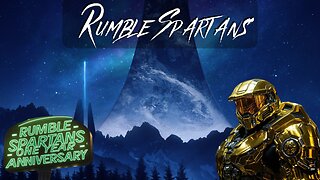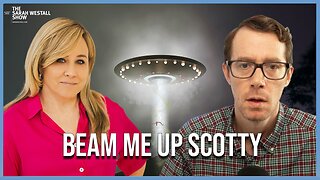Premium Only Content

Mini CERN Fermi Lab Chicago Lights Up The Sky ?
WTF ?
Fermi Lab 🥼 Particle Accelerator, Chicago, Illinois
1.) Fermilab | Home
Special Note 📝 For Next Article -
See the acronym DUNE - Deep Underground Neutrino Experiment !!!
2.) Fermilab's Main Injector, two miles (3.3 km) in circumference, is the laboratory's most powerful particle accelerator.[3] The accelerator complex that feeds the Main Injector is under upgrade, and construction of the first building for the new PIP-II linear accelerator began in 2020.[4] Until 2011, Fermilab was the home of the 6.28 km (3.90 mi) circumference Tevatronaccelerator. The ring-shaped tunnels of the Tevatron and the Main Injector are visible from the air and by satellite.
Fermilab aims to become a world center in neutrino physics. It is the host of the multi-billion dollar Deep Underground Neutrino Experiment (DUNE) now under construction.[5] The project has suffered delays and, in 2022, the journals Science and Scientific American each published articles describing the project as "troubled".[6][7] Ongoing neutrino experiments are ICARUS (Imaging Cosmic and Rare Underground Signals) and NOνA (NuMIOff-Axis νe Appearance). Completed neutrino experiments include MINOS(Main Injector Neutrino Oscillation Search), MINOS+, MiniBooNE and SciBooNE (SciBar Booster Neutrino Experiment) and MicroBooNE (Micro Booster Neutrino Experiment).
On-site experiments outside of the neutrino program include the SeaQuestfixed-target experiment and Muon g-2. Fermilab continues to participate in the work at the Large Hadron Collider(LHC); it serves as a Tier 1 site in the Worldwide LHC Computing Grid.[8]Fermilab also pursues research in quantum information science.[9] It founded the Fermilab Quantum Institute in 2019.[10] Since 2020, it also is home to the SQMS (Superconducting Quantum Materials and Systems) Center.[11]
Asteroid 11998 Fermilab is named in honor of the laboratory.
3.) Discoveries by Fermilab experiments
edit
The following particles were first directly observed at Fermilab:

Fermilab's CDF detector
• The top quark[34] announced in 1995 by the DØ experiment and CDF experiment.
• The bottom quark, which was observed as a quark-antiquark pair called the Upsilon meson[35] announced in 1977 by Experiment 228.
• The tau neutrino, announced in July 2000 by the DONUT collaboration.[36]
• The bottom Omega baryon (
Ω−
b), announced by the DØ experiment of Fermilab in 2008.[37]
In 1999, physicists at on the KTeV experiment were also the first to observe direct CP violation in kaondecays.[38]
The DØ experiment and CDF experimenteach made important contributions to the observation of the Higgs Boson, announced in 2012.[39]
Evolution of the post-Tevatron experimental program
edit
Fermilab dismantled the CDF (Collider Detector at Fermilab)[40] experiment to make the space available for IARC (Illinois Accelerator Research Center).[41]
Fermilab physicists continue to play a key role in the world-wide collider program. The LHC Physics Center (LPC) at Fermilab is a regional center of the Compact Muon Solenoid Collaboration (the experiment is housed at CERN). The LPC offers a vibrant community of CMS scientists from the US and plays a major role in the CMS detector commissioning, and in the design and development of the detector upgrade.[42] Fermilab is the host laboratory for USCMS,[43] which includes researchers from 50 U.S. universities including 715 students. Fermilab hosts the largest CMS Tier 1 computing center, handling approximately 40% of global CMS Tier 1 computing requests. On February 9, 2022, Fermilab's Patricia McBride (physicist) was elected spokesperson of the CMS collaboration.[44]
During this time-frame, the laboratory also established a new program in research in cutting-edge information science, including the development of quantum teleportation technology[45]for the quantum internet and increasing the lifetime of superconducting resonators[46] for use in quantum computers.
On-site program in the 2020s
edit
The on-site program in the 2020s is largely focused on the ``Intensity Frontier of particle physics, especially neutrino physics and rare physics searches using muons. A program exploring nucleon structure is also continuing.
List of recent past, ongoing, and planned experiments running on-site
edit
• ANNIE: The Accelerator Neutrino Neutron Interaction Experiment [47](Status, June 2023: completed run, planned future run)
• Deep Underground Neutrino Experiment(DUNE), formerly known as Long Baseline Neutrino Experiment (LBNE)[48](Status, June 2023: planned future run)
• ICARUS experiment: Originally located at the Laboratori Nazionali del Gran Sasso(LNGS) and moved to Fermilab. [49](Status, June 2023: running)
• MiniBooNE: Mini Booster Neutrino Experiment[50] (Status, June 2023: completed run)
• MicroBooNE: Micro Booster Neutrino Experiment[51] (Status, June 2023: completed run)
• MINERνA: Main INjector ExpeRiment with νs on As[52] (Status, June 2023: completed run)
• Mu2e: Muon-to-Electron Conversion Experiment[53] (Status, June 2023: planned future run)
• Muon g−2: Measurement of the anomalous magnetic dipole moment of the muon[54] (Status, June 2023: completed run)
• NOνA: NuMI Off-axis νe Appearance[55](Status, June 2023: running)
• SeaQuest[56] (Status, June 2023: completed run)
• SBND: Short-Baseline Neutrino Detector[57] (Status, June 2023: planned future run)
• SpinQuest [58] (Status, June 2023: planned future run)
LBNF/DUNE
edit
Fermilab strives to become the world leader in neutrino physics through the Deep Underground Neutrino Experimentat the Long Baseline Neutrino Facility. Other leaders are CERN, which leads in Accelerator physics with the Large Hadron Collider (LHC), and Japan, which has been approved to build and lead the International Linear Collider(ILC). Fermilab will be the site of LBNF's future beamline, and the Sanford Underground Research Facility (SURF), in Lead, SD, is the site selected to house the massive far detector. The term "baseline" refers to the distance between the neutrino source and the detector. The far detector current design is for four modules of instrumented liquid argon with a fiducial volume of 10 kilotons each.
According to the 2016 Conceptual Design Report, the first two modules were expected to be complete in 2024, with the beam operational in 2026. The final modules were planned to be operational in 2027.[59] In 2022, the cost for two far detector modules and the beam, alone, had risen to $3B. This led to a decision by the Department of Energy Office of Science to phase the experiment.[6] Phase I would consist of two modules, to be completed in 2028-29, and the beamline, to be completed in 2032. The installation of phase II, the remaining two far detector modules, is not yet planned and will be at a cost above the $3B estimate for phase I.[6]
A large prototype detector constructed at CERN took data with a test beam from 2018-2020. The results show that ProtoDUNE performed with greater than 99% efficiency.[60]
LBNF/DUNE program in neutrino physics plans to measure fundamental physical parameters with high precision and to explore physics beyond the Standard Model. The measurements DUNE will make are expected to greatly increase the physics community's understanding of neutrinos and their role in the universe, thereby better elucidating the nature of matter and anti-matter. It will send the world's highest-intensity neutrino beam to a near detector on the Fermilab site and the far detector 800 miles (1300 km) away at SURF.
About other neutrino experiments
edit
The MiniBooNE detector was a 40-foot (12 m) diameter sphere containing 800 tons of mineral oil lined with 1,520 phototube detectors. An estimated 1 million neutrino events were recorded each year. SciBooNE sat in the same neutrino beam as MiniBooNE but had fine-grained tracking capabilities. The NOνA experiment uses, and the MINOS experiment used, Fermilab's NuMI(Neutrinos at the Main Injector) beam, which is an intense beam of neutrinos that travels 455 miles (732 km) through the Earth to the Soudan Mine in Minnesota and the Ash River, Minnesota, site of the NOνA far detector. In 2017, the ICARUS neutrino experiment was moved from CERN to Fermilab.[61][62]
Muon g−2
edit
Main article: Muon g−2
Muon g−2: (pronounced “gee minus two”) is a particle physics experiment to measure the anomaly of the magnetic moment of a muon to a precision of 0.14 ppm, which will be a sensitive test of the Standard Model.

Muon g−2 building (white and orange) which hosts the magnet
Fermilab is continuing an experiment conducted at Brookhaven National Laboratory to measure the anomalous magnetic dipole moment of the muon.
The magnetic dipole moment (g) of a charged lepton (electron, muon, or tau) is very nearly 2. The difference from 2 (the "anomalous" part) depends on the lepton, and can be computed quite exactly based on the current Standard Model of particle physics. Measurements of the electron are in excellent agreement with this computation. The Brookhaven experiment did this measurement for muons, a much more technically difficult measurement due to their short lifetime, and detected a tantalizing, but not definitive, 3 σ discrepancy between the measured value and the computed one.
The Brookhaven experiment ended in 2001, but 10 years later Fermilab acquired the equipment,[63] and is working to make a more accurate measurement (smaller σ) which will either eliminate the discrepancy or, hopefully, confirm it as an experimentally observable example of physics beyond the Standard Model.

Transportation of the 600 ton magnet to Fermilab
Central to the experiment is a 50 foot-diameter superconducting magnet with an exceptionally uniform magnetic field. This was transported, in one piece, from Brookhaven in Long Island, New York, to Fermilab in the summer of 2013. The move traversed 3,200 miles over 35 days, mostly on a barge down the East Coast and up the Mississippi.
-
 LIVE
LIVE
SpartakusLIVE
7 hours agoDuos w/ StevieT || Trios or Quads Later?!
140 watching -
 LIVE
LIVE
OhHiMark1776
8 hours ago🟢04-27-25 ||||| Halo Multiplayer Rumble: No. 13 ||||| Halo MCC (2019)
339 watching -
 2:12:28
2:12:28
TheSaltyCracker
5 hours agoThey Killed Her ReeEEEe Stream 04-27-25
134K266 -
 2:33:51
2:33:51
vivafrei
15 hours agoEp. 261: Criminal Judges ARRESTED! Election in Canada! Santos Sentenced! RFK Jr. & Autism & MORE!
181K105 -
 6:24:31
6:24:31
Amish Zaku
8 hours agoRumble Spartans "The One Year" Event
43.5K1 -
 LIVE
LIVE
Illyes Jr Gaming
6 hours agoLaid Back Sunday Night Warzone Stream!
74 watching -
 1:51:18
1:51:18
Nerdrotic
7 hours ago $6.78 earnedDiscoveries From Graham Hancock's "Fight for the Past" | Forbidden Frontier 099
46.5K12 -
 1:09:42
1:09:42
Sarah Westall
6 hours agoHidden Tech Resembles Star Trek: Malaysian Airline, Portals & Wormholes w/ Ashton Forbes
54.9K21 -
 1:13:46
1:13:46
Josh Pate's College Football Show
7 hours ago $1.87 earnedCFB Truth About NFL Draft | Sheduer & Ewers Slide | James Franklin vs Fans | 2025’s Biggest What-Ifs
21.3K5 -
 4:44:14
4:44:14
Due Dissidence
14 hours agoTrump's Polling COLLAPSES, WI Judge ARRESTED, Biden DRAGGED at WHCD, Corporations PULL Pride Funding
39.2K36